
How to Use USR-ES1 W5500 lite: Examples, Pinouts, and Specs
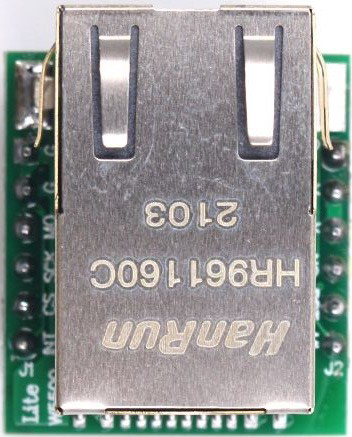
 Design with USR-ES1 W5500 lite in Cirkit Designer
Design with USR-ES1 W5500 lite in Cirkit DesignerIntroduction
The USR-ES1 W5500 lite is a compact Ethernet module designed to simplify the process of connecting microcontrollers to the internet. It is built around the W5500 chip, which integrates a full TCP/IP stack, enabling reliable and efficient communication over Ethernet networks. This module supports multiple socket connections, making it an excellent choice for Internet of Things (IoT) applications, home automation, industrial control systems, and other network-enabled projects.
Explore Projects Built with USR-ES1 W5500 lite
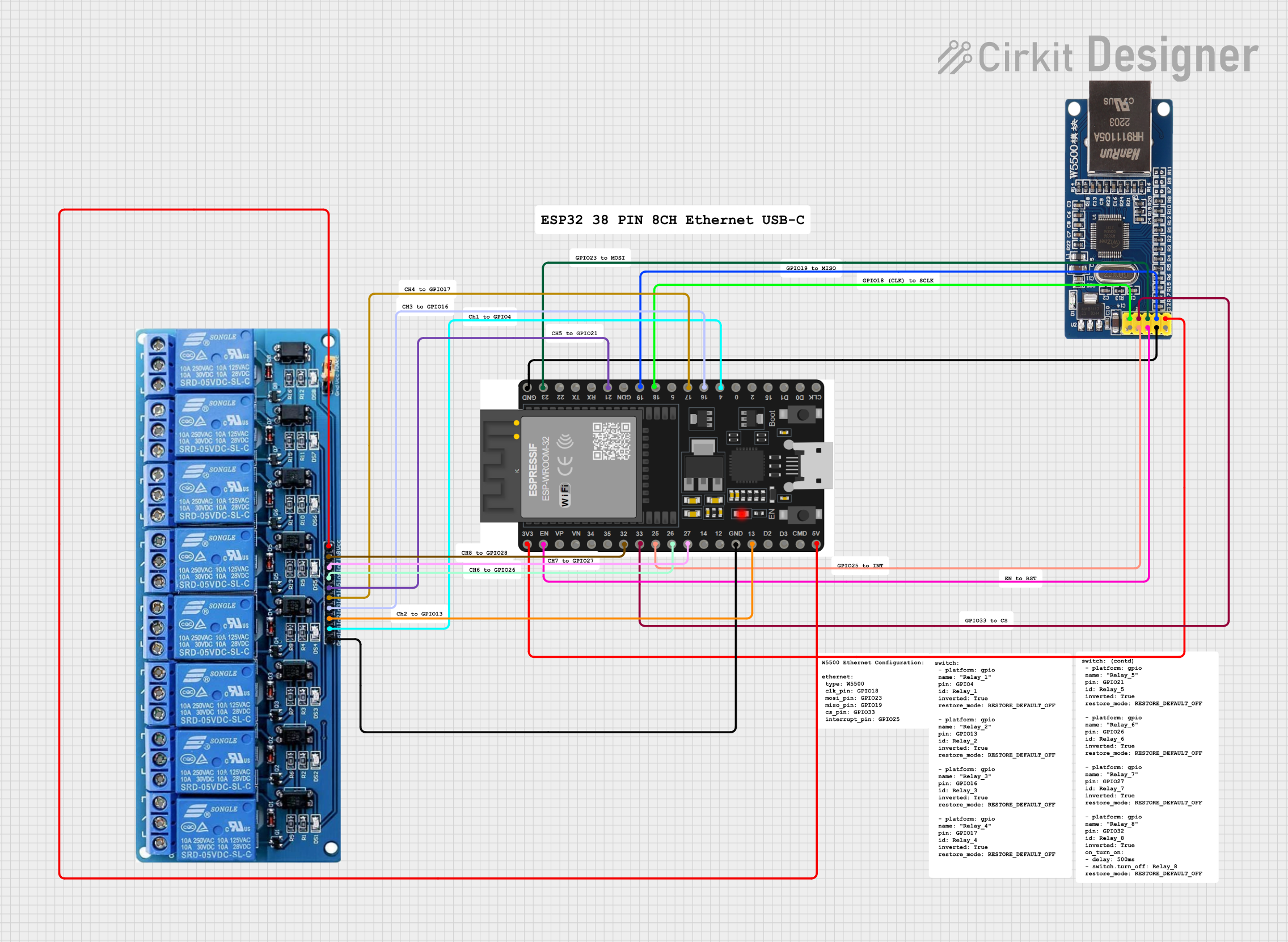
 Open Project in Cirkit Designer
Open Project in Cirkit Designer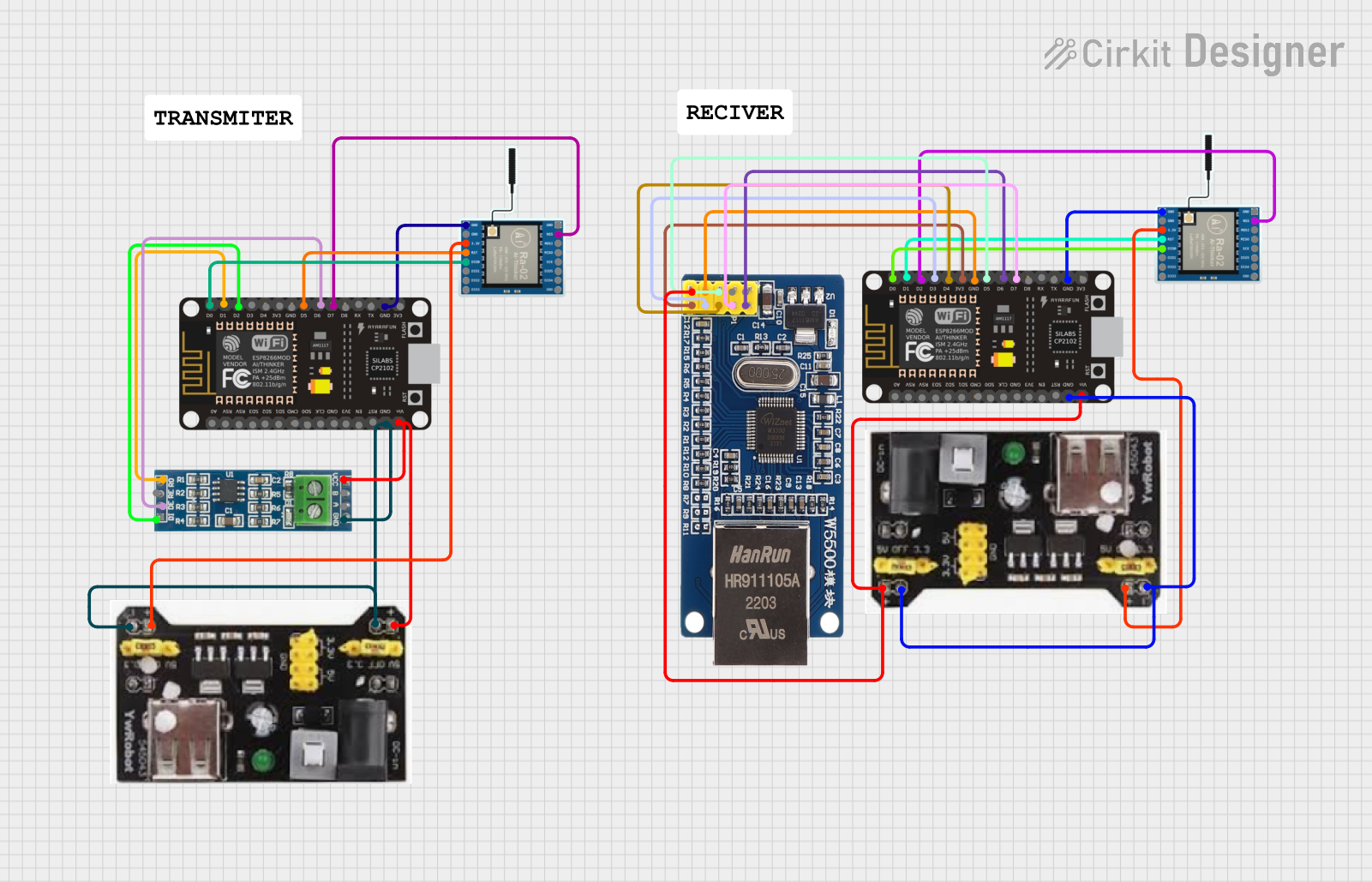
 Open Project in Cirkit Designer
Open Project in Cirkit Designer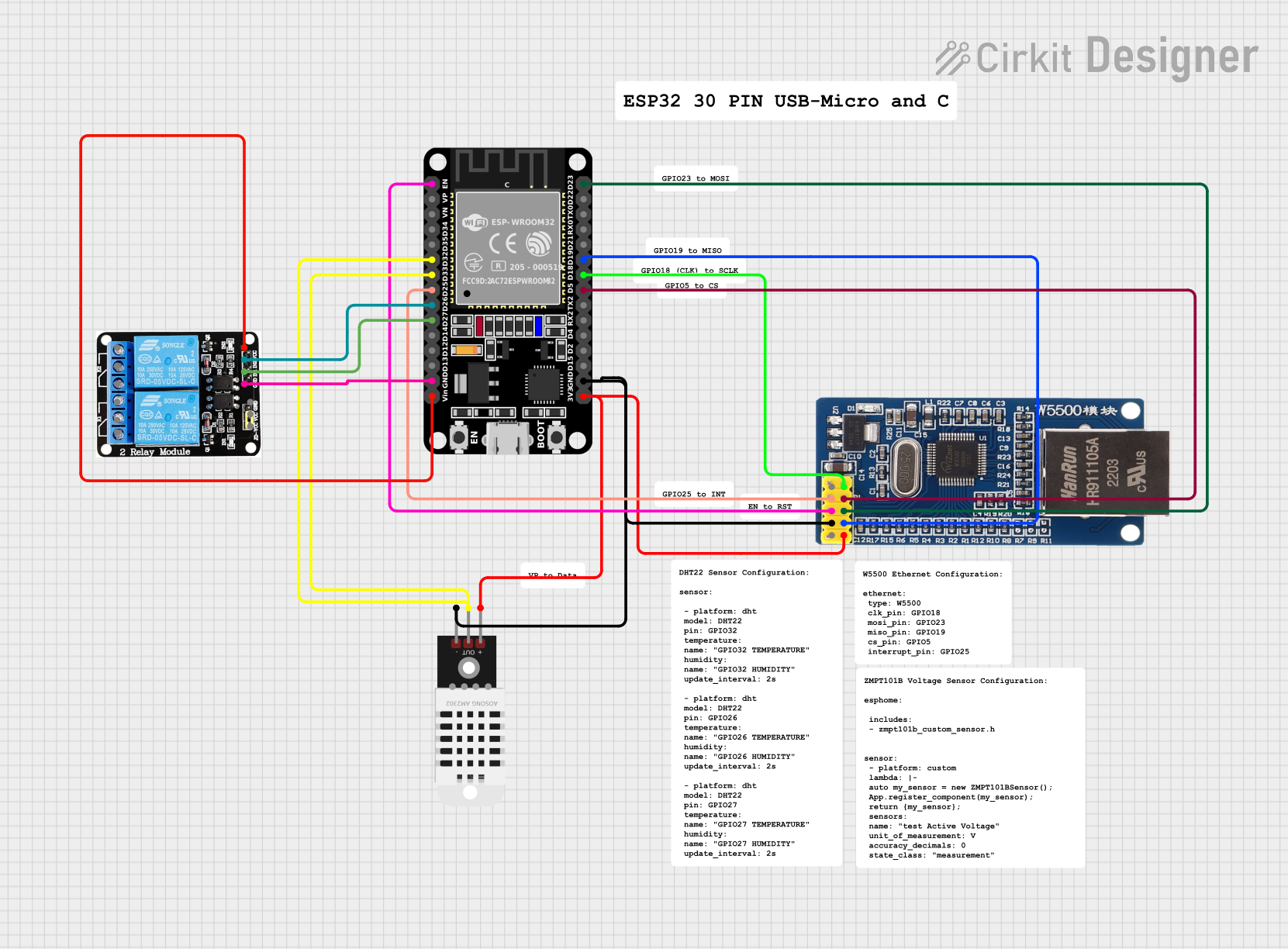
 Open Project in Cirkit Designer
Open Project in Cirkit Designer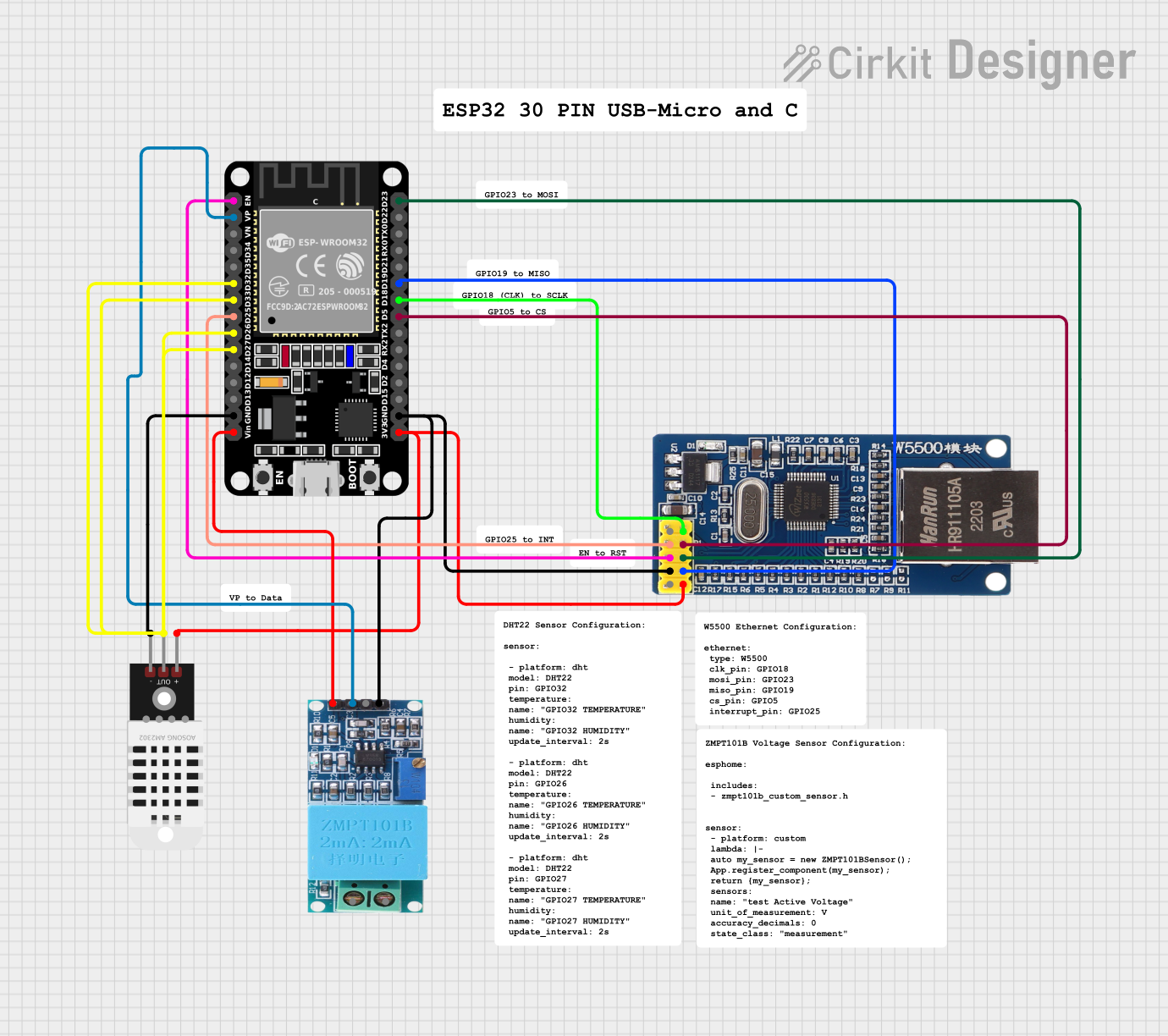
 Open Project in Cirkit Designer
Open Project in Cirkit DesignerExplore Projects Built with USR-ES1 W5500 lite

 Open Project in Cirkit Designer
Open Project in Cirkit Designer
 Open Project in Cirkit Designer
Open Project in Cirkit Designer
 Open Project in Cirkit Designer
Open Project in Cirkit Designer
 Open Project in Cirkit Designer
Open Project in Cirkit DesignerCommon Applications and Use Cases
- IoT devices requiring Ethernet connectivity
- Home automation systems
- Industrial monitoring and control
- Data logging and remote server communication
- Network-enabled embedded systems
Technical Specifications
The USR-ES1 W5500 lite module is designed to provide robust and efficient Ethernet communication. Below are its key technical details:
Key Technical Details
- Chipset: W5500 (Hardwired TCP/IP stack)
- Network Protocols: TCP, UDP, ICMP, IPv4, ARP, IGMP, PPPoE
- Ethernet Speed: 10/100 Mbps
- Operating Voltage: 3.3V
- Current Consumption: ~132 mA (typical)
- Socket Connections: Up to 8 simultaneous sockets
- Interface: SPI (Serial Peripheral Interface)
- Operating Temperature: -40°C to +85°C
- Dimensions: 23mm x 25mm
Pin Configuration and Descriptions
The USR-ES1 W5500 lite module has a simple pinout for easy integration with microcontrollers. Below is the pin configuration:
| Pin | Name | Description |
|---|---|---|
| 1 | GND | Ground connection |
| 2 | 3.3V | Power supply (3.3V input) |
| 3 | MISO | SPI Master-In-Slave-Out (data output from the module to the microcontroller) |
| 4 | MOSI | SPI Master-Out-Slave-In (data input from the microcontroller to the module) |
| 5 | SCK | SPI Clock signal |
| 6 | CS | Chip Select (active low, used to enable SPI communication with the module) |
| 7 | INT | Interrupt output (used to signal events to the microcontroller) |
| 8 | RST | Reset pin (active low, used to reset the module) |
Usage Instructions
The USR-ES1 W5500 lite module is straightforward to use in a circuit. Below are the steps and best practices for integrating it into your project.
How to Use the Component in a Circuit
- Power Supply: Connect the 3.3V pin to a stable 3.3V power source and the GND pin to the ground.
- SPI Interface: Connect the SPI pins (MISO, MOSI, SCK, and CS) to the corresponding SPI pins on your microcontroller.
- Interrupt Pin: Optionally, connect the INT pin to a GPIO pin on your microcontroller to handle interrupts.
- Reset Pin: Connect the RST pin to a GPIO pin or a reset circuit to allow manual or software-controlled resets.
- Ethernet Connection: Plug an Ethernet cable into the RJ45 connector on the module.
Important Considerations and Best Practices
- Ensure the module is powered with a clean and stable 3.3V supply to avoid communication issues.
- Use proper pull-up or pull-down resistors on the SPI lines if required by your microcontroller.
- Keep the SPI clock frequency within the W5500's supported range (up to 80 MHz).
- Use a shielded Ethernet cable for better signal integrity in noisy environments.
- If using the module with an Arduino, ensure the SPI pins (MISO, MOSI, SCK, and CS) are correctly mapped to the Arduino's hardware SPI pins.
Example Code for Arduino UNO
Below is an example of how to use the USR-ES1 W5500 lite module with an Arduino UNO to establish a basic Ethernet connection.
#include <SPI.h>
#include <Ethernet.h>
// MAC address for the Ethernet module
byte mac[] = { 0xDE, 0xAD, 0xBE, 0xEF, 0xFE, 0xED };
// IP address for the device (adjust as needed)
IPAddress ip(192, 168, 1, 177);
// Initialize the Ethernet server on port 80
EthernetServer server(80);
void setup() {
// Start the serial communication for debugging
Serial.begin(9600);
while (!Serial) {
; // Wait for the serial port to connect (for Leonardo boards)
}
// Start the Ethernet connection
if (Ethernet.begin(mac) == 0) {
Serial.println("Failed to configure Ethernet using DHCP");
// If DHCP fails, use a static IP address
Ethernet.begin(mac, ip);
}
// Print the assigned IP address
Serial.print("IP Address: ");
Serial.println(Ethernet.localIP());
// Start the server
server.begin();
Serial.println("Server is ready");
}
void loop() {
// Listen for incoming clients
EthernetClient client = server.available();
if (client) {
Serial.println("New client connected");
// Read and echo the client's request
while (client.connected()) {
if (client.available()) {
char c = client.read();
Serial.write(c); // Echo the data to the serial monitor
// Respond to the client
client.println("HTTP/1.1 200 OK");
client.println("Content-Type: text/html");
client.println("Connection: close");
client.println();
client.println("<!DOCTYPE HTML>");
client.println("<html>");
client.println("<h1>Hello from USR-ES1 W5500 lite!</h1>");
client.println("</html>");
break;
}
}
// Close the connection
client.stop();
Serial.println("Client disconnected");
}
}
Troubleshooting and FAQs
Common Issues Users Might Face
No Ethernet Connection:
- Ensure the Ethernet cable is securely connected to the module and the router.
- Verify that the module is powered with a stable 3.3V supply.
- Check the MAC and IP address configuration in the code.
SPI Communication Failure:
- Confirm that the SPI pins are correctly connected to the microcontroller.
- Ensure the CS pin is properly configured in the code and is not shared with other devices.
Interrupts Not Working:
- Verify that the INT pin is connected to a GPIO pin on the microcontroller.
- Check the microcontroller's interrupt configuration.
Module Not Responding:
- Reset the module using the RST pin.
- Check for loose connections or damaged components.
Solutions and Tips for Troubleshooting
- Use a multimeter to verify power and signal connections.
- Test the module with a simple example sketch to isolate issues.
- Update the Ethernet library to the latest version for compatibility with the W5500 chip.
- Use a logic analyzer or oscilloscope to debug SPI communication if necessary.
By following this documentation, you can effectively integrate the USR-ES1 W5500 lite module into your projects and troubleshoot common issues.